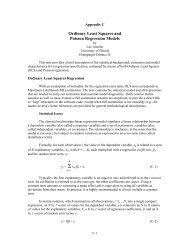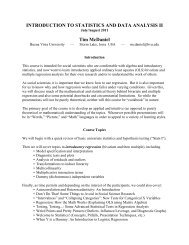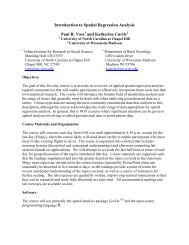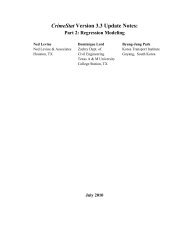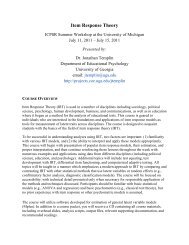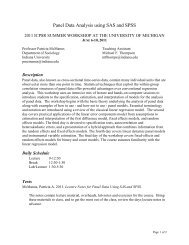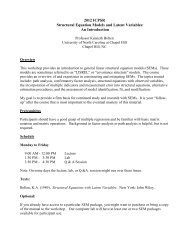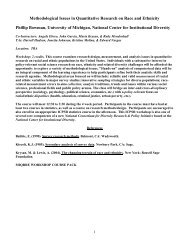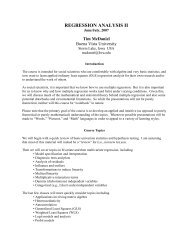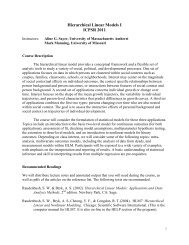Regression Analysis I: An Introduction - icpsr
Regression Analysis I: An Introduction - icpsr
Regression Analysis I: An Introduction - icpsr
You also want an ePaper? Increase the reach of your titles
YUMPU automatically turns print PDFs into web optimized ePapers that Google loves.
<strong>Regression</strong> <strong><strong>An</strong>alysis</strong> I: <strong>An</strong> <strong>Introduction</strong><br />
Saundra K. Schneider<br />
Michigan State University<br />
This course provides an introduction to the theory, methods, and practice of regression analysis.<br />
The goals are to provide students with the skills that are necessary to: (1) read, understand, and<br />
evaluate the professional literature that uses regression analysis; (2) design and carry out studies<br />
that employ regression techniques for testing substantive theories; and (3) prepare to learn about<br />
more advanced statistical procedures.<br />
<strong>An</strong>y course of this type must assume a working knowledge of elementary statistical concepts and<br />
techniques. We will conduct a brief review at the beginning of the course, but students must be<br />
familiar with such ideas as descriptive statistics, sampling distributions, statistical inference, and<br />
hypothesis testing, before moving on to the more complicated matters that will comprise the<br />
majority of the course material. The course will not dwell on statistical theory. But, we will<br />
focus on the nature of the basic regression model, and the development of the regression<br />
estimators. We will see that this model depends very heavily on several assumptions. Therefore,<br />
we will examine these assumptions in detail, considering why they are necessary, whether they<br />
are valid in practical research situations, and the consequences of violating them in particular<br />
applications of the regression techniques. These formal, analytic treatments will be<br />
counterbalanced by the use of frequent substantive examples and class exercises. Again, the<br />
overall course objective is not to turn you into a statistician-- instead, we are trying to maximize<br />
your research skills as a social scientist.<br />
Formal course requirements are as follows: (1) Class attendance and active participation. This is<br />
mandatory. Statistical knowledge is cumulative, and gaps in the early material will always have<br />
detrimental consequences later on. (2) Completion of class assignments. Most of these are<br />
computer exercises, designed to familiarize you with the application of various concepts and<br />
techniques introduced in class. Each of these assignments will focus on a specific set of topics.<br />
However, the latter assignments are cumulative in the sense that they build upon earlier material<br />
in the class.
The following are the recommended texts for the course:<br />
Michael S. Lewis-Beck. Applied <strong>Regression</strong>: <strong>An</strong> <strong>Introduction</strong>.<br />
Larry D. Schroeder, David L. Sjoquist, Paula E. Stephan. Understanding <strong>Regression</strong><br />
<strong><strong>An</strong>alysis</strong>: <strong>An</strong> Introductory Guide.<br />
McKee J. McClendon. Multiple <strong>Regression</strong> and Causal <strong><strong>An</strong>alysis</strong> OR<br />
Damodar N. Gujarati. Basic Econometrics, 4 th Edition.<br />
The following books are useful reference books:<br />
George W. Bohrnstedt and David Knoke. Statistics for Social Data <strong><strong>An</strong>alysis</strong>.<br />
Lawrence C. Hamilton. Modern Data <strong><strong>An</strong>alysis</strong>: A First Course in Applied Statistics.<br />
Thomas H. Wonnacott and Ronald J. Wonnacott. Introductory Statistics.<br />
Neil A. Weiss. Introductory Statistics.<br />
The following books are supplemental:<br />
William D. Berry. Understanding <strong>Regression</strong> Assumptions.<br />
William D. Berry and Stanley Feldman. Multiple <strong>Regression</strong> in Practice.<br />
Peter Kennedy. 2008. A Guide to Econometrics (6 th Edition)..<br />
John Fox. <strong>Regression</strong> Diagnostics.<br />
Jeffrey M. Wooldridge. 2006. Introductory Econometrics: A Modern Approach (3rd<br />
Edition)..<br />
Students should pay special attention to the readings in the recommended texts. This material is<br />
critical for the course. It would be wise to read all the material assigned in the recommended<br />
texts and to purchase these texts for our own library. Note: You should select either McClendon<br />
or Gujarati as a recommended text. You should also have access to a basic reference book, such<br />
as Bohrnstedt and Knoke, Hamilton, Weiss, or Wonnacott and Wonnacott. Although these<br />
reference books are not required texts, they will prove useful for reviewing basic concepts and<br />
earlier material. <strong>An</strong>d they will also provide reasonable alternative discussions of the bivariate<br />
and multiple regression models. Most of the supplemental books are either too specialized or<br />
advanced to be used as central texts in a course of this type. However, several of them are very<br />
good and would be extremely useful books to add to your own library.<br />
After you have selected your texts, use the readings listed on the following pages to follow along<br />
with the material. You do NOT need to read all of the material in all the texts. But, it is wise to<br />
keep up with the readings in the recommended texts you have chosen.
Topics and Reading Assignments<br />
I. <strong>Introduction</strong> to <strong>Regression</strong> <strong><strong>An</strong>alysis</strong><br />
Reading: McClendon, pp. 1-19<br />
Gujarati, pp. 15-32<br />
II.<br />
Preliminary Material and Statistical Review<br />
A. Frequency Distributions, Univariate Summary Statistics, Probability<br />
Distributions<br />
Reading: McClendon, pp. 20-25<br />
Hamilton, pp. 3-110<br />
Bohrnstedt and Knoke, pp. 27-92, 135-154<br />
Wonnacott and Wonnacott, pp. 25-60, 109-116, 124-141<br />
Weiss, pp. 2-231<br />
B. Statistical Inference and the Properties of Statistical Estimators<br />
Reading: Hamilton, pp. 241-259<br />
1. Confidence Intervals & Hypothesis Tests<br />
Reading: Hamilton, pp. 260-354<br />
Bohrnstedt and Knoke, pp. 154-179<br />
Wonnacott and Wonnacott, pp. 254-264, 287-297, 300-310, 314-317<br />
Weiss, pp. 280-485<br />
2. Differences Between Two Means, Two Variances, Etc.<br />
Reading: Hamilton, pp. 397-456<br />
Bohrnstedt and Knoke, pp. 187-212<br />
Wonnacott and Wonnacott, pp. 265-273<br />
Weiss, pp. 486-647<br />
C. Linear Combinations<br />
Reading: Mcclendon, pp. 25-28<br />
Wooldridge, pp. 707-802
III.<br />
The Bivariate <strong>Regression</strong> Model<br />
A. <strong>Introduction</strong>: Basic Ideas and Concepts<br />
Reading: Lewis-Beck, pp. 9-26<br />
Schroeder, Sjoquist, and Stephan, pp. 11-23<br />
McClendon, pp. 28-30<br />
Gujarati, pp. 37-57<br />
Hamilton, pp. 457-476<br />
Berry, pp. 1-22<br />
Bohrnstedt and Knoke, pp. 253-266<br />
Wonnacott and Wonnacott, pp. 357-370<br />
Weiss, pp. 694-741<br />
B. The Least Squares Criterion and Estimation in the Bivariate <strong>Regression</strong> Model<br />
Reading: McClendon, pp. 42-49<br />
Gujarati, pp. 58-80<br />
Berry and Feldman, pp. 31-41<br />
Hamilton, pp. 468-477<br />
Bohrnstedt and Knoke, pp. 266-274, 284-286<br />
Wonnacott and Wonnacott, pp. 474-496<br />
Kennedy, pp. 11-59<br />
Wooldridge, pp. 50-66, 89-95, 106-109, 123-126, 176-181, 187-190<br />
C. Good of fit, the Correlation Coefficient and R 2<br />
Reading: Schroeder, Sjoquist, and Stephan, pp. 23-29<br />
McClendon, pp. 42-49<br />
Gujarati, pp. 79-94<br />
Hamilton, pp. 477-483<br />
D. Assumptions Underlying the Bivariate Linear <strong>Regression</strong> Model<br />
Reading: McClendon, pp. 133-146<br />
Gujarati, pp. 65-74; 107-110<br />
Berry and Feldman, pp. 9-12<br />
Kennedy, pp. 11-59
E. Statistical Inference, Confidence Intervals, and Hypothesis Tests<br />
Reading: Lewis-Beck, pp. 26-47<br />
Schroeder, Sjoquist, and Stephan, pp. 36-53<br />
Gujarati, pp. 119-163<br />
Hamilton, pp. 503-525<br />
Bohrnstedt and Knoke, pp. 277-284<br />
Wonnacott and Wonnacott, pp. 372-395<br />
Kennedy, pp. 51-90<br />
Wooldridge, pp. 126-147<br />
Weiss, pp. 742-797<br />
F. Summary, Extensions, and a Preliminary Look at Residuals, Outliers, and<br />
Influential Cases<br />
Reading: McClendon, pp. 49-59<br />
Gujarati, pp. 164-193<br />
Hamilton, pp. 492-495, 535-551<br />
Berry, pp. 22-88<br />
IV.<br />
The Multiple <strong>Regression</strong> Model<br />
A. <strong>Introduction</strong>: Notation, Assumptions, and Interpretation<br />
Reading: Lewis-Beck, pp. 47-54<br />
Schroeder, Sjoquist, and Stephan, pp. 29-32<br />
McClendon, pp. 60-80<br />
Gujarati, pp. 202-211; 230-233<br />
Hamilton (MDA), pp. 563-566<br />
Bohrnstedt and Knoke, pp. 381-390<br />
Wonnacott and Wonnacott, pp. 396-406<br />
Berry and Feldman, pp. 9-18<br />
Wooldridge, pp. 73-88<br />
B Measures of Goodness of Fit<br />
Reading: Schroeder, Sjoquist, and Stephan, pp. 32-36<br />
McClendon, pp. 80-83<br />
Gujarati, pp. 211-225<br />
Bohrnstedt and Knoke, pp. 392-396<br />
Wonnacott and Wonnacott, pp. 496-501
C. Statistical Inference and the Role of Hypothesis Testing<br />
Reading: McClendon, pp. 133-174<br />
Gujarati, pp. 248-272<br />
Hamilton, pp. 566-568<br />
Bohrnstedt and Knoke, pp. 396-409<br />
Wonnacott and Wonnacott, pp. 406-408<br />
Berry and Feldman, pp. 9-18<br />
Kennedy, pp. 60-80<br />
Wooldridge, pp. 147-167, 214-218<br />
D. Summary and a Brief Look at Extensions<br />
Reading: McClendon, pp. 93-116<br />
Gujarati, pp. 273-297<br />
Hamilton (RWG), pp. 83-101<br />
V. Model Building in Multiple <strong>Regression</strong> <strong><strong>An</strong>alysis</strong><br />
A. Models of Substantive Phenomena and the Importance of Model Assumptions<br />
Reading: Lewis-Beck, pp. 63-66<br />
McClendon, pp. 83-93<br />
Hamilton, pp. 574-576<br />
Wonnacott and Wonnacott, pp. 410-424<br />
Berry, pp. 1-24<br />
B. Model Specification<br />
Reading: Lewis-Beck, pp. 30-45<br />
Schroeder, Sjoquist, and Stephan, pp. 67-70<br />
McClendon, pp. 288-321<br />
Gujarati, pp. 506-560<br />
Berry, pp. 30-45<br />
Berry and Feldman, pp. 18-26<br />
Kennedy, pp. 71-92
C. Nominal Independent Variables<br />
Reading: Schroeder, Sjoquist, and Stephan, pp. 56-58<br />
McClendon, pp. 198-229<br />
Gujarati, pp. 297-334<br />
Hamilton, pp. 576-580<br />
Bohrnstedt and Knoke, pp. 409-419<br />
Kennedy, pp. 248-258<br />
Wooldridge, pp. 230-252<br />
D. Functional Forms and Nonlinear Models<br />
Reading: Schroeder, Sjoguist, and Stephan, pp. 58-61<br />
McClendon, pp. 230-287<br />
Gujarati, pp. 561-577<br />
Berry, pp. 60-66<br />
Hamilton, pp. 583-584<br />
Berry and Feldman, pp. 51-72<br />
Kennedy, pp. 93-111<br />
Wooldridge, pp. 304-390<br />
VI.<br />
Potential Problems in Multiple <strong>Regression</strong> <strong><strong>An</strong>alysis</strong><br />
A. Interpretation of Results<br />
Reading: Hamilton, pp. 568-573<br />
Bohrnstedt and Knoke, pp. 274-275, 390-392<br />
Fox, pp.3-5<br />
B. Multicollinearity and Its Effects<br />
Reading: Lewis-Beck, pp. 58-63<br />
Schroeder, Sjoquist, and Stephan, pp. 71-72<br />
Gujarati, pp. 506-560<br />
McClendon, pp. 161-163<br />
Wonnacott and Wonnacott, pp. 501-506<br />
Hamilton, pp. 580-581<br />
Berry, pp. 24-27<br />
Berry and Feldman, pp. 37-50<br />
Kennedy, pp. 192-202<br />
Fox, pp. 10-21<br />
Wooldridge, pp. 101-105
C. Nonnormal and Nonconstant (Heteroscedastic) Errors<br />
Reading: Schroeder, Sjoquist, and Stephan, pp. 75-77<br />
McClendon, pp. 174-195<br />
Gujarati, pp. 441-503<br />
D. Measurement Error<br />
Berry and Feldman, pp. 73-88<br />
Berry, pp. 67, 72-81<br />
Fox, pp. 40-53<br />
Kennedy, pp. 133-139<br />
Wooldridge, pp. 181-185<br />
Reading: Schroeder, Sjoquist, and Stephan, pp. 70-71<br />
Gujarati, pp. 524-528<br />
Berry and Feldman, pp. 26-37<br />
Berry, pp. 45-60<br />
Kennedy, pp. 157-163<br />
Wooldridge, pp. 318-325<br />
E. Residual <strong><strong>An</strong>alysis</strong>, Outliers, and Influential Observations<br />
Reading: Gujarati, pp. 518-524<br />
Berry, pp. 27-29<br />
Fox, pp. 21-40<br />
Kennedy, pp. 372-388<br />
VII.<br />
Additional Topics<br />
A. Dichotomous Dependent Variables<br />
Reading: Schroeder, Sjoquist, and Stephan, pp. 79-80<br />
Gujarati, pp. 580-636<br />
Wooldridge, pp. 252-258<br />
B Simultaneous Equation Models<br />
Reading: Schroeder, Sjoquist, and Stephan, pp. 77-79<br />
Gujarati, pp. 715-791<br />
McClendon, pp. 288-347<br />
Berry, pp. 1-54
C. A Brief <strong>Introduction</strong> to Time Series Models<br />
Reading: Schroeder, Sjoquist, and Stephan, pp. 72-75<br />
Gujarati, pp. 792-865<br />
Berry, pp. 67-72<br />
Kennedy, pp. 139-156, 163-179



